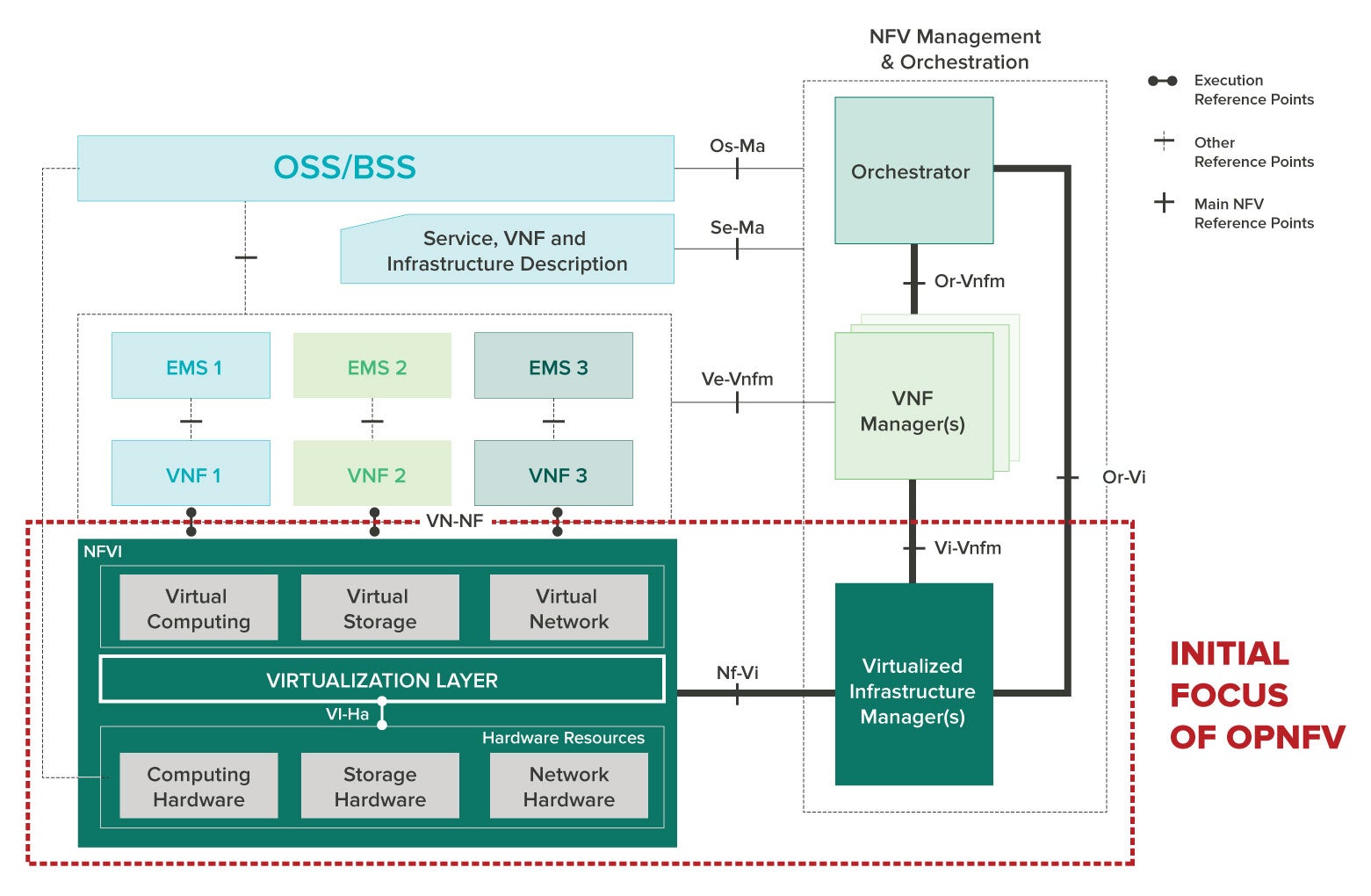New NFV platform will accelerate cloud-based delivery models for operators, enable interoperability and accelerate standards through an open source reference implementation
SAN FRANCISCO, September 30, 2014 – The Linux Foundation, the nonprofit organization dedicated to accelerating the growth of Linux and collaborative development, today announced the founding of the Open Platform for NFV Project (OPNFV). OPNFV will be a carrier-grade, integrated, open source reference platform intended to accelerate the introduction of new products and services.
Platinum-level founding members include AT&T, Brocade, China Mobile, Cisco, Dell, Ericsson, HP, Huawei, IBM, Intel, Juniper Networks, NEC, Nokia Networks, NTT DOCOMO, Red Hat, Telecom Italia and Vodafone. Silver-level founding members include 6WIND, Alcatel-Lucent, ARM, Broadcom, CableLabs, Cavium, CenturyLink, Ciena, Citrix, ClearPath Networks, ConteXtream, Coriant, Cyan, Dorado Software, Ixia, Metaswitch Networks, Mirantis, Ooredoo, Orange, Overture Networks, Sandvine, Sprint and Wind River.
“Open source code has been proven to accelerate innovation and time to market for new technologies,” said Jim Zemlin, executive director at The Linux Foundation. “The Open Platform for NFV will bring together providers, cloud and infrastructure vendors, developers and users alike to define a new type of reference platform for the industry, integrating existing open source building blocks with new components and testing that accelerates development and deployment of NFV. We are excited to host this important industry initiative that will provide a common foundation for the future of networks.”
Network Functions Virtualization (NFV) and Software-Defined Networking (SDN) are part of the overall industry shift towards network and application virtualization. Together they are expected to dramatically change the networking landscape, allowing providers to deliver new services to their customers more quickly while significantly reducing both operating and capital expenditures. These technologies bring both cloud computing and Information Technology (IT) capabilities and benefits into the telecom industry, enabling new levels of flexibility and business growth opportunities for providers. Service provider applications have different demands than most IT applications, so an open platform integrating multiple open source components and ensuring continuous testing for carrier-grade service performance is essential to this transition.
OPNFV will establish a carrier-grade, integrated, open source reference platform that industry peers will build together to advance the evolution of NFV and ensure consistency, performance and interoperability among multiple open source components. Because multiple open source NFV building blocks already exist, OPNFV will work with upstream projects to coordinate continuous integration and testing while filling development gaps.
OPNFV is expected to increase performance and power efficiency; improve reliability, availability and serviceability; and deliver comprehensive platform instrumentation. The initial scope of OPNFV will be on building NFV infrastructure (NFVI) and Virtualized Infrastructure Management (VIM) leveraging existing open source components where possible.
The initial project objectives are to:
- develop an integrated and tested open source platform that can be used to investigate and demonstrate core NFV functionality;
- include proactive participation of leading end users to validate that OPNFV meets the needs of the end user community;
- contribute to and participate in relevant open source projects that will be leveraged in the OPNFV reference platform;
- establish an open ecosystem for NFV solutions based on open standards and open source software; and
- promote OPNFV as the preferred open reference platform.
While not developing standards, OPNFV will work closely with ETSI’s NFV ISG, among others, to drive consistent implementation of standards for an open NFV reference platform. When open source software development is aligned with standards development, it can root out issues early, identify resolutions and become the de facto codebase, resulting in a far more economical approach to platform development.
OPNFV will license new components under the Apache License Version 2.0 and will work within the licensing requirements of upstream projects in order to contribute code back to these projects. A Board of Directors and Technical Steering Committee (TSC) will govern the initiative. The Board will be made up of representatives from member companies and will set the business direction and scope of the project. The TSC will also provide technical governance and leadership for the project.
Board officers for OPNFV include:
- Prodip Sen, board chair (HP)
- Margaret Chiosi, president (AT&T)
- Wenjing Chu, secretary (Dell)
- Hui Deng, treasurer (China Mobile)
OPNFV is a Linux Foundation Collaborative Project. Collaborative Projects are independently funded software projects that harness the power of collaborative development to fuel innovation across industries and ecosystems. By spreading the collaborative DNA of the largest collaborative software development project in history, The Linux Foundation provides the essential collaborative and organizational framework so project hosts can focus on innovation and results. Linux Foundation Collaborative Projects span the enterprise, mobile, embedded and life sciences markets and are backed by many of the largest names in technology. For more information about Linux Foundation Collaborative Projects, please visit: http://collabprojects.linuxfoundation.org. To learn more about OPNFV and start contributing today, please visit: http://www.opnfv.org.
Comments from ETSI
Dr. Steven Wright (AT&T), the newly elected Chairman of the NFV ISG commented: “I congratulate the OPFNV founders on the formation of this new open source community supporting NFV. The NFV ISG’s mission is to facilitate the industry transformation and development of an open, interoperable, ecosystem through specification, implementation and deployment experience. The ISG recognizes the value of open source implementations to converge industry requirements and facilitate the development of the NFV ecosystem. I look forward to the future releases of the integrated open source infrastructure platform from OPNFV.”
Comments from OpenDaylight
“Open source is quickly becoming a de facto standard for cloud platforms (Openstack), SDN (OpenDaylight) and virtual switches (Open vSwitch) because it’s a neutral playing field that everyone can build on and integrate with. I see strong interest from carriers to leverage these open source projects for their NFV deployments and we look forward to collaborating with OPNFV as they work to stitch these technologies together,” said Neela Jacques, executive director, OpenDaylight Project.
Comments from OpenStack
“NFV will help carriers and enterprises deliver new and innovative services to their customers much more efficiently,” said Jonathan Bryce, Executive Director, OpenStack Foundation. “The OpenStack community has been working to address the massive opportunity NFV presents, and we look forward to collaborating with OPNFV to advance these critical infrastructure efforts through open source development.”
Comments from Open vSwitch
“The telecom industry is going through a major transition, led by the increased adoption of network virtualization to transform how service providers build and operate their networks,” said Justin Pettit, staff engineer, VMware, and project lead and a leading contributor for Open vSwitch. “This type of evolution requires broad collaboration among leading companies, developers and open source projects.”
Comments from Platinum-Level Members
AT&T
“As a member, AT&T hopes OPNFV will create an Open Platform with software and hardware to expedite NFV implementation. OPNFV is a unique organization that provides an ecosystem for users to work directly with the Open Source development community for an NFV platform,” said Margaret T. Chiosi, Distinguished Network Architect, AT&T Labs.
Brocade
“Operators are seeking new business models that facilitate the expansion of services and revenue streams, while lowering operational costs and complexity,” said Ken Cheng, chief technology officer (CTO) at Brocade. “As a founding member of OPNFV, Brocade will draw on its years of SDN and NFV development to collaborate with service providers and industry peers in order to accelerate the adoption of these transformational technologies.”
China Mobile
“We are happy to see many operators to work together to jointly develop NFV platform,” said Bill Huang, GM of China Mobile Research Institute. “We expect OPNFV to lead the open source development of next generation core network elements and application.”
Cisco
“It’s perfect timing for the emergence of an open platform and developer community in the networking industry to accelerate NFV, service chaining and cloud-based services,” said David Ward, Senior Vice President, Chief Architect, and Chief Technology Officer-Development, Cisco. “Our goal for the community is to drive successful co-development and co-innovation with our customers, partners and community of users. We will not only contribute running code and Cisco resources to the OPNFV community, we will utilize the efforts of OPNFV internally to accelerate our ability to bring innovative, interoperable solutions to market. This consortium creates what developers, providers, enterprises and vendors need – a common platform for NFV innovation acceleration.”
Dell
“OPNFV will allow service providers access to the latest technologies and innovations for cloud-based service delivery,” said Arpit Joshipura, vice president, Dell Networking. “We’re dedicated to OPNFV’s mission and proud to participate as a founding Platinum member in this important initiative.”
Ericsson
“There are important standards in place for SDN and NFV, as well as a variety of open source components. OPNFV will bring these elements together to create an open NFV platform for users and advance new products and services. We will work with our customers, our partners and everyone involved in the OPNFV project to deliver openness and superior performance in the Networked Society,” said Erik Ekudden, VP Technology Strategies, Ericsson.
HP
“With OPNFV, we are attempting to create a new approach to networking standardization,” said Prodip Sen, CTO, NFV Business Unit, HP. “Rather than relying on an extended standardization process followed by implementation, we are pursuing an iterative model, with an open source framework serving as the standardization mechanism. The shared implementation experience of users and vendors should foster interoperability and accelerate adoption and deployment of NFV. Our expertise in SDN and NFV, and our participation in other open source projects, will help us contribute significantly to this effort.”
IBM
“The networking industry is undergoing a major transformation, one in which software-defined networks and network function virtualization are opening up new opportunities for users and vendors alike,” said Inder Gopal, VP, Cloud Networking, IBM. “As a founding member of OPNFV, we look forward to working with other members to bring an industry ecosystem together that will accelerate this industry transformation.”
Huawei
“Huawei envisions that Network Function Virtualization (NFV) has the potential to enable the network of the future to be much more nimble, flexible, and scalable,” said Dr. Anthony C.K. Soong, IEEE Fellow and Chief Scientist from Huawei. “We look forward to building a healthy ecosystem and better explore the future together with our peers. As an enabler of this virtualization, OPNFV will become an important corner stone in the ICT industry. It will increase the rate of innovation, equip the industry for novel business models, and speed up the development of the ecosystem that will enrich our lives.”
Intel
“The continued momentum towards adopting server, cloud and virtualization technologies in service provider networks will bring many benefits including lower operating costs and faster deployment of new services. OPNFV will accelerate NFV and SDN solutions in the market that are interoperable and scalable and Intel is looking forward to contributing to this important project,” said Sandra Rivera, Senior Director of Market Development, Intel Corporation.
Juniper Networks
“The time is right for OPNFV, as it brings the industry together to build a common platform to drive consistency and adoption of new technologies in order to enable faster service creation. This will not only create very real opportunities for vendors and service providers, but ultimately yield greater benefits to end customers,” said Paul Obsitnik, vice president, Service Provider Marketing at Juniper Networks. “Our commitment to open standards is in our DNA and is the foundation for co-creation and driving innovation. We look forward to achieving breakthrough results with our industry peers.”
NEC
NEC has long prioritized open source and collaborative development for ICT platforms to enable the introduction of innovative new services at higher speed and lower cost,” said Atsuo Kawamura, Senior Vice President, NEC. “NEC will drive OPNFV to develop a common platform for best-of-breed, multivendor NFV applications, integrated by advanced orchestration solutions, to enable operators’ profitable growth. NEC’s carrier solutions will adopt OPNFV to offer market leading NFV applications and services.”
Nokia Networks
“With OPNFV we are building the foundation for agility and flexibility in NFV and SDN solutions,” says Henri Tervonen, Head of Mobile Broadband Architecture, Nokia Networks. “We are committed to being hardware and cloud stack agnostic, and OPNFV is a part of delivering on that commitment.”
NTT DOCOMO
“OPNFV is an unique initiative which brings all these elements together, where Operators, Service Providers, Vendors and the Open Source community join hands together to deliver an open reference platform for NFV,” said Dr. Hiroshi Nakamura, Senior Vice President and Managing Director of Core Network Development Department, NTT DOCOMO, Inc. “DOCOMO has been at the forefront of faster service rollout and cutting-edge network platform deployment. DOCOMO will lead the OPNFV to create the foundation of emerging NFV ecosystem across industries.”
Red Hat
“Red Hat understands the value of open source software and collaboration and is prioritizing innovation to enable the next-generation of cloud-based services,” said Chris Wright, Technical Director, SDN and NFV, Red Hat. “We’re pleased to join the OPNFV Project to help move forward the needed standards and code to enable service providers to offer a new level of services on their networks.”
Telecom Italia
“OPNFV will provide a needed platform for integration and testing of key NFV features for operators,” said Luigi Licciardi, head of standards, IPR and Research Coordination, Telecom Italia. “We’re excite to be able to actively participate and contribute to this important work that will benefit the industry overall.”
Vodafone
“It’s important to Vodafone to advance the state-of-the-art of telecommunications networks,” said Luke Ibbetson, Group R&D Director, Vodafone. “OPNFV gives us a vehicle to do just that.”
About Open Platform for NFV (OPNFV)
Open Platform for NFV is a carrier-grade, integrated, open source reference platform intended to accelerate the introduction of new products and services using NFV. It brings together service providers, vendors and users to collaborate in an open forum on advancing the state-of-the-art in NFV. For more information, please visit: http://www.opnfv.org.
About The Linux Foundation
The Linux Foundation is a nonprofit consortium dedicated to fostering the growth of Linux and collaborative software development. Founded in 2000, the organization sponsors the work of Linux creator Linus Torvalds and promotes, protects and advances the Linux operating system and collaborative software development by marshaling the resources of its members and the open source community. The Linux Foundation provides a neutral forum for collaboration and education by hosting Collaborative Projects, Linux conferences, including LinuxCon and generating original research and content that advances the understanding of Linux and collaborative software development. More information can be found at http://www.linuxfoundation.org.



 Chris Price
Chris Price